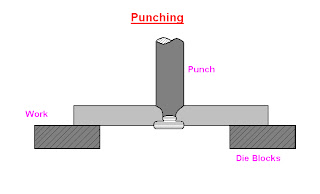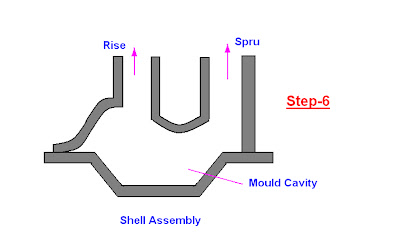Forging and its types
Forging is the operation where the metal is heated and then a force is applied to manipulates the metals in such a way that the required final shape is obtained. Forging is generally a hot working process through cold forging is used sometimes.
Type of forging
1. smith forging
2. drop forging
3. press forging
4. machine forging
1: Smith forging
This is the traditional forging operation done openly or in-openly dies by the village black smith or modern shop floor by manual hammering or by the power hammer. The process involves heating the stock in the black smith hearth and then beating it over the anvil. To get the desire shape the operator has to manipulate the component in between the blows.
The types of operation available are fullering, flattering, bending , upsetting and swaging.
2: Drop forging
Basic definition:
This is the operation done in closed impression dies by means drop hammer here the force for shaping the component is applied in a series of blows.
Drop forging utilizes a closed impression die to obtain the desire shape of the component , the shaping is done by the repeated hammering given to the material in the die cavity. The equipment use for delivering for blows are called drop hammers. The drop forging die consists of two halves. The lower halve of the die is fixed to the anvil of the machine , while the upper halve is fixed to ram. The heated stock is kept in the lower die, while the ram delivers 4-5 blows on the metal spreads and completely fills in the die cavity. When the two die of halves closed the complete is formed. The typical products obtained in drop forging are cranks, crank shaft, connecting rods, wrench, crane hooks etc. The types of operations are fullering, edging, bending, blocking , finishing and trimming etc.
3: Press forging
Similar to the drop forging , the press forging is also done in closed impression dies with the expectation that the force is continuous squeezing type applied by the hydraulic press. Press forging dies are similar to drop forging dies as also the process in press forging, the metal is shaped not by means of a series of blows as in drop forging , but by means of a single continuous squeezing action. This squeezing is obtained by means of hydraulic presses. Because of the continuous action of by hydraulic presses, the material gets uniformly deform through out its entire depth ,the press forging dies with the various impression , such as fuller, bender and finisher impression properly arranged .
4: Machine forging:
Unlike the press or drop forging where the material is drawn out , in machine forging the material is only upset to get the desire shape. As it involves the upsetting operation some time it is simply called as upset forging. Originally this was develop for making bolts head in a continuous fashion, but now there are fairly large number of diverse.
Uses of this process:
Because of the beneficial grain flow obtain from upsetting. It is used for making gears, blanks, shafts, excels, and similar parts. Upsetting machine called up setter are generally horizontal acting. The die set consists of die and corresponding punch or a heading tool. The die consists of two parts, one called the stationary gripper die which is fixed to the machine frame and the other movable gripper die which moves along with the die slide of the up setter. The stock is held then between these two gripper dies.
The upset forging cycle start with the, movable die sliding against the stationary die to grip the stock. The two dies when in closed position from the necessary die cavity then the heading tool advance against the stock and upset it to completely filled to the die cavity.
Having completed the upsetting the heading tool moves back to its back position. Then the movable gripper die releases the stock by sliding backward. Similar to drop forging it is not possible to get the final shape in a single pass in machine forging also. Therefore the operation is carried out in number of stages. The die cavities is required for the various operations are all arrange vertically on the gripper dies. The stock is the move from stage one to another in proper sequence till the final forging is ready. A heading tool each for every upsetting stage is arranged on the heading slide of the upsetting machine. A typical upsetting die and heading tool is shown:







 3:52 PM
3:52 PM
 , Posted in
, Posted in



























